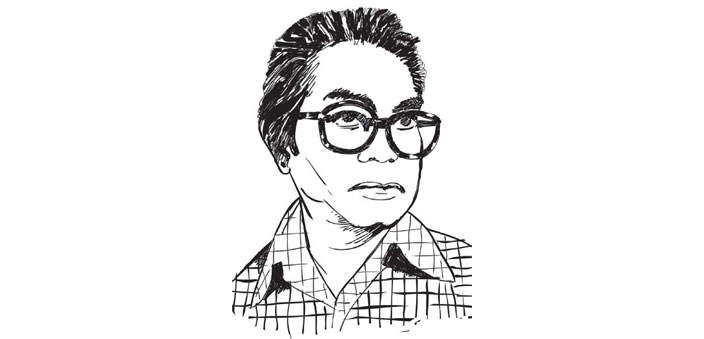Abstractionist par excellence (1924-2001)
IT takes decades to realise quiet reaches of imagination of an artist trying to break new grounds and create his or her own niche. V.S.Gaitonde who travelled the unknown terrain in a lonely journey was no exception. Gaitonde and his art are in the main news columns mainly due to high valuation of his art work sold in the first auction held by Christie’s in India. His works stand out and is lauded in art circles for its far reaching influence over art scene in India due to its intellectual content and spiritual ethos.
He was a loner, a kind of recluse who immersed himself in his art and became one with his own canvas. There arrived a stage when you could not dissociate him from his work. He was a defiant rebel, without words he fought with his own environment, preferred his own solitude than interact with people around him and went on experimenting with his own way of expression. With his philosophical bend of mind, influenced by Maharishi Mahesh Yogi, he literarily went beyond reality and searched inner void and filled it with his own colours and formless non-objects. He was not very happy with the categorisation of his art as “abstract” form and wanted it to be described as “non-objective”. He firmly believed that nothing can be described as abstract art.
Like Van Gogh, he suffered a lot, was most noncommunicative and said very little about his own art works and went on discovering different calligraphic abstractions. Like many masters, he also did not get recognition during his life time, nor bothered about worldly attention towards his art. An art film, made by Paris based Indian artist Sunil Kaldate, is remarkable visual essay based on his personality and work. The outstanding film is full of silences and shows echoes of nature in his work. He was fond of music and reading and spent most of his time processing this thoughts or understanding into visual forms. As a result, unlike his contemporaries, he did not produce large body of works.
Like him, most of his works are not available for public view as they are with small number of discerning art collectors. His art works mesmerise viewers, awe struck by its simplicity and silence and transports them to different world where you may not understand meaning but feel the work and experience the walk through a new horizon.
One of his avid lovers said, “Silence in his works is like soothing music to eyes”. Gaitonde created his own hues of colours by mixing and matching different shades, experimenting over years. One can also hear pain of a tormented soul through ancient calligraphic signs and their positioning within available space. An art graduate of the J. J. School of Art, Mumbai, in 1948, he was attracted to the Progressive Artists Group which evolved around 1950s, but retained his own distinct identity. Unlike his non-objective work of his later phase, he began his journey by distinctly figurative work rendered in gouache and moved on in his own solitary path in unknown terrain. During early 1950s, Gaitonde worked in the Bhulabhai Institute, where he used to take interest in Alkazi’s theatre unit and Ravi Shankar’s school of music and dance since both were housed in same premises. Unlike his other contemporaries, he was not affected by the changing values in Indian art and society, and defiantly continued his own search for ultimate truth through nontraditional non-objective visual medium.
He was awarded the highly coveted JDR Fund in 1965 to visit USA for enhancing art appreciated works by American artists experimenting and capturing contemporary life by using abstract expressionism. Despite his reluctance to get involved in art movements, he went on to win the Bombay Art Society award in 1950 and an award at the Asian Artists exhibition for his work ‘The Bird and The Egg’. He was associated with Gallery 59 promoted by artist Bal Chhabda since its inception.
The Guggenheim Museum, New York is organising Gaitonde’s retrospective this year. Maharashtra has also almost forgotten him, but Chinha, magazine devoted to art, is also brining out a book on his personality and art to satisfy long standing demand by his avid followers. Gaitonde‘s five decade long existence as an artist is unique and he is rated as one of the best painter of Indian modernism by none other than another Indian mascot M.F.Husain.

